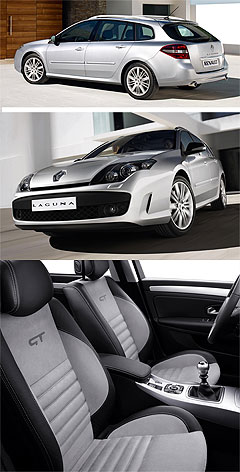Lovely Renault Laguna GT hits France
BY DAVID HASSALL | 17th Apr 2008

Renault Australia plans to initially continue pursuing its single-model diesel strategy for the new Laguna, which will be launched here in June.
However, if the new model gains wider acceptance than the current Laguna diesel, which averaged only a little more than six sales a month last year, then the company is keen to add other variants to the local line-up, including a wagon.
Renault Australia marketing communications manager Craig Smith said it was too early to comment on future model possibilities for the Laguna range, but indicated that the company was interested in the GT, which comes with both petrol and diesel engines.
“If the Laguna launch goes well in June we may have a look at it,” he said. “We would certainly like to have it. It looks the goods.”However, he issued a note of warning that the GT’s market appeal in Australia was restricted by the fact that it does not come with an automatic transmission.
The Laguna GT features two engine variants and a different nose to the regular series, which has already proven to be very popular in Europe since being launched there five months ago.
It sits at the top of the Laguna range in France and will be rolled out across Europe in the coming months.

This propels the car from rest to 100km/h in 7.8 seconds while average fuel consumption is rated at 8.5L/100km.
Laguna GTs fitted with the 2.0-litre dCi turbo-diesel have 131kW on tap at 3750rpm and 400Nm from just 2000rpm, thanks to a “reduced-inertia” variable-nozzle turbocharger.
Although the diesel is just 0.6 seconds slower to 100km/h (at 8.5 seconds) than the petrol model, average fuel consumption is considerably better at just 6.5L/100km.
Renault claims that the GT’s front-end styling is more assertive than the standard Laguna, with a different radiator grille, lateral air intakes and headlights set against a black background.
The car’s sporty look is enhanced by full-length side sills, gloss black wing mirrors, smoked tail-lights and straight-section twin exhausts.
It sits on big 18-inch Celsium alloy wheels fitted with 225/45-section Bridgestone Potenza tyres (maximising the F1 connection between the companies) and is stopped by 320mm discs at the front and 300mm discs at the rear.
GT logos are embossed on the seats, which have extra lateral support and charcoal leather upholstery, while the interior also features a three-spoke leather steering wheel, matching gearknob and cross-drilled aluminium pedals.
Renault claims that four-wheel steering systems in the 1980s were designed to overcome understeer in front-drive cars and were made redundant by electronic stability control.
However, the French car-maker says that new technology developed by its Japanese parent, Nissan, has resulted in greatly improved dynamic ability.
“Towards the end of the 1990s, car-makers like Nissan were beginning to develop solutions based on electrically and even hydraulically operated activators with a view to taking the dynamic performance of their vehicles forward,” said Renault.
“Electronic control of the rear wheels has enabled handling to be fine-tuned even further, notably in the case of rear-wheel drive vehicles.”Renault says that its ‘Active Drive’ system responds to driver inputs every 10 milliseconds to deliver better handling and greater safety by reacting quickly to unexpected driving situations.
At speeds of less than 60km/h, the rear wheels turn up to 3.5 degrees in the opposite direction to the front wheels to reduce the amount of steering required. It also reduces the car’s turning circle by 10 per cent – from 12.0 metres to 10.8 metres – making the big Laguna the same as a Clio.
Laguna sales in 30 countries have already topped 42,000, while a further 51,000 orders have been taken in western Europe – 87 per cent of which are for diesels and 43 per cent for the top Dynamique specification level, on which the GT is based.